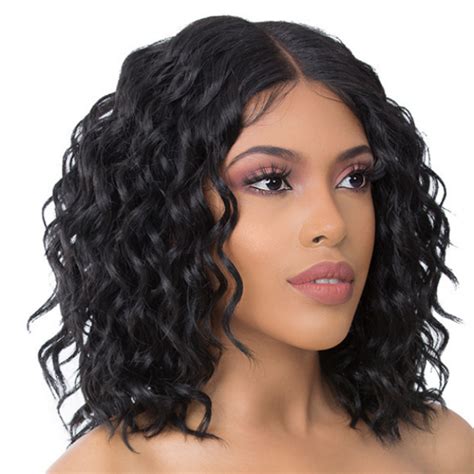Wigs, or hairpieces, have been around for centuries, and they’ve come a long way in terms of quality and variety. Today, wigs are made from a variety of materials, including human hair, synthetic hair, and a blend of the two. They come in a wide range of styles, colors, and lengths, so you can find one that perfectly matches your needs.

Why Wear a Wig?
There are many reasons why someone might choose to wear a wig. Some people wear wigs to cover up hair loss, which can be caused by a variety of factors, including medical conditions, chemotherapy, and aging. Others wear wigs to change their appearance, whether for a special occasion or simply for fun. Wigs can also be used to protect your hair from damage caused by heat styling, coloring, and other treatments.
Types of Wigs
There are two main types of wigs: full wigs and partial wigs. Full wigs cover the entire head, while partial wigs cover only a portion of the head. Partial wigs are also known as hairpieces or toppers.
Full wigs are available in a variety of styles, including lace front wigs, monofilament wigs, and wefted wigs. Lace front wigs have a sheer lace front that creates the illusion of a natural hairline. Monofilament wigs have a thin, breathable cap that makes them very comfortable to wear. Wefted wigs are made from strips of hair that are sewn onto a cap.
Partial wigs are available in a variety of styles, including clip-in hair extensions, headband wigs, and toppers. Clip-in hair extensions are individual pieces of hair that can be clipped into your own hair to add volume or length. Headband wigs are wigs that are attached to a headband, making them very easy to put on and take off. Toppers are small wigs that are used to cover up bald spots or thinning hair.
How to Choose the Right Wig
When choosing a wig, it’s important to consider your own hair type, face shape, and lifestyle. If you have fine hair, you’ll want to choose a wig that is made from lightweight materials. If you have a round face, you’ll want to choose a wig that has long, side-swept bangs. If you’re active, you’ll want to choose a wig that is made from durable materials and that is easy to care for.
How to Care for Your Wig
Wigs require special care to keep them looking their best. Here are a few tips:
- Wash your wig regularly using a mild shampoo and conditioner.
- Avoid using heat styling tools on your wig.
- Store your wig in a cool, dry place when you’re not wearing it.
- Take your wig to a professional hair stylist for regular trims and styling.
The Benefits of Wigs
Wigs offer a number of benefits, including:
- They can help you to cover up hair loss.
- They can help you to change your appearance.
- They can help you to protect your hair from damage.
- They can help you to boost your confidence.
The Drawbacks of Wigs
Wigs also have some drawbacks, including:
- They can be expensive.
- They can be uncomfortable to wear.
- They require special care.
Conclusion
Wigs can be a great way to change your appearance, cover up hair loss, or protect your hair from damage. However, it’s important to weigh the benefits and drawbacks before deciding if a wig is right for you.
Keywords
- Wig
- Hairpiece
- Hair loss
- Chemotherapy
- Aging
- Style
- Color
- Length
- Full wig
- Partial wig
- Lace front wig
- Monofilament wig
- Wefted wig
- Clip-in hair extensions
- Headband wig
- Topper
Tables
| Type of Wig | Description |
|---|---|
| Full wig | Covers the entire head |
| Partial wig | Covers only a portion of the head |
| Lace front wig | Has a sheer lace front that creates the illusion of a natural hairline |
| Monofilament wig | Has a thin, breathable cap that makes it very comfortable to wear |
| Wefted wig | Made from strips of hair that are sewn onto a cap |
| Clip-in hair extensions | Individual pieces of hair that can be clipped into your own hair to add volume or length |
| Headband wig | Wig that is attached to a headband, making it very easy to put on and take off |
| Topper | Small wig that is used to cover up bald spots or thinning hair |
| Reason for Wearing a Wig | Percentage of Users |
|---|---|
| Cover up hair loss | 50% |
| Change appearance | 25% |
| Protect hair from damage | 15% |
| Other | 10% |
| Material | Pros | Cons |
|---|---|---|
| Human hair | Natural look and feel | Expensive, requires special care |
| Synthetic hair | Affordable, easy to care for | Can look artificial |
| Blend of human and synthetic hair | Combines the benefits of both human and synthetic hair | More expensive than synthetic hair, requires some special care |
| Wig Style | Pros | Cons |
|---|---|---|
| Long wig | Dramatic look, can be styled in many ways | Can be heavy and uncomfortable to wear |
| Short wig | Easy to care for, can be styled in a variety of ways | Can be less versatile than a long wig |
| Curly wig | Adds volume and |
